Shipping Box
Shipping boxes are rectangular containers of corrugated cardboard or other materials. They are designed to protect items during transportation. Shipping boxes come in different sizes, shapes, and styles depending on the user's needs. For example, some boxes have double walls or extra cushioning to protect fragile items. Others have handles or perforations for easy opening.
Usages of shipping boxes
Shipping boxes are versatile containers offering a range of shipping and storage benefits. They are essential for many individuals and businesses transporting or storing products safely and securely.
1. Shipping Items Safely
Shipping boxes are ideal for shipping various items, such as oversized or fragile products. When shipping oversized products, such as furniture, electronics, or machinery, smaller mailer boxes are not suitable due to their size limitations and structural design. In contrast, shipping boxes are durable, sturdy, and can withstand rough handling and transportation. They can protect the products from damage, scratches, and other types of wear and tear during transit. Moreover, shipping boxes can also be used for shipping small products in bulk. They act as secondary packaging, allowing you to pack multiple products in one box and secure them with cushioning material or bubble wrap for added protection.
2. Storing Products
Shipping boxes are not only valid for shipping products but also for storing them. They are an excellent storage solution for various products, such as clothes, books, toys, and other household items. Shipping boxes are strong enough to withstand being stacked on each other and can help you save space in your storage area. Moreover, shipping boxes are made of durable materials such as cardboard, corrugated fiberboard, or plastic, which can protect the products from dust, humidity, and other environmental factors. Additionally, shipping boxes can be labeled and organized, making it easy to find specific products when needed.
Commonly used materials for shipping box
E, B, EE, and EB flute cardboard are the most commonly used materials for shipping boxes. These materials are preferred for their strength and durability, which makes them capable of withstanding the rigors of transportation. Although plastic, metal, or wood can be used for specific purposes, cardboard is the most popular choice for shipping boxes.
Types of Shipping Boxes
The slotted containers have a significant market share in the shipping industry and are commonly used for storage and delivery purposes. The most commonly used type of slotted container is the regular slotted container (RSC), although other variations also exist.
1. Regular Slotted Carton (RSC, 0201)
The Regular Slotted Carton is a widely used shipping box due to its standard design, making it a popular choice for automated manufacturing. It has flaps of equal length from the score to the edge, with the significant flaps meeting in the middle. The minor flaps do not meet except when the length and width are equal. This design saves materials without compromising the box's functionality.


2. Center Special Corrugated Carton Box(CSCC, 0204)
This carton design is almost the same as the regular slotted carton. The only difference is that this type has flaps of different lengths. The inner or outer flaps are cut to meet at the center. Because all flaps meet at the center, the box's top and bottom have double the corrugated thickness, and the product rests on a level base when placed inside the box.
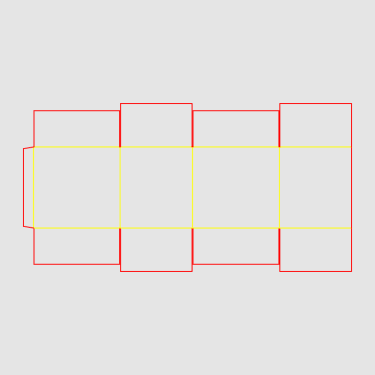
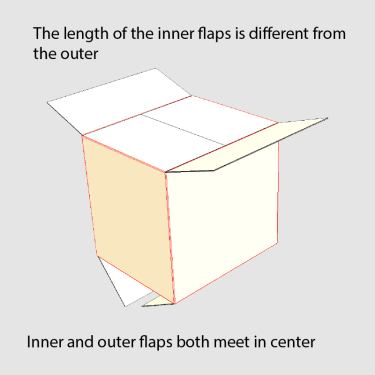
3. Semi Overlap Slotted Carton(SOSC, OSC, 0202)
This type of box is similar to the regular slotted carton, but the outside flaps overlap by an inch or more instead of meeting in the center of the box. All flaps have the same length, and the box is typically closed with staples through the outer flaps. It is ideal for transporting something long, such as a pole or beam. The overlapping flaps prevent the box flaps from pulling apart and help ensure the contents remain secure during transport.
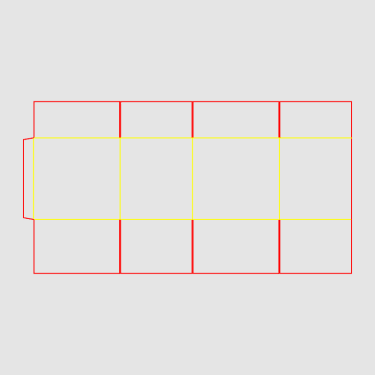

4. Full Overlap Slotted Carton(FOL, 0203)
This type has a similar construction to the RSC type. It has equal-length hinged flaps on top and bottom, but the difference is that these flaps overlap entirely when closed, which means extra thickness on its top and bottom that can provide extra cushioning or more stacking strength.


5. Half Slotted Carton(HSC, 0200)
A half-slotted carton is a type of shipping box that is constructed in a similar way to the RSC type. The main difference between the two is that the half-slotted carton only has one set of flaps attached to its bottom, with no flaps on its top. This makes it suitable for displaying merchandise during transport.
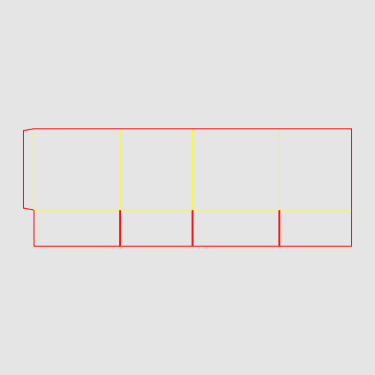
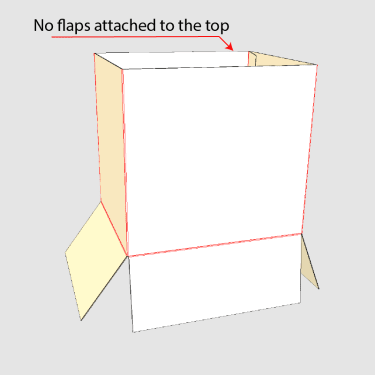
6. Center Special Overlap Slotted Carton(CSO, 0205)
When this box is closed, its inner flaps meet at the center while the outer flaps overlap. The amount of overlap depends on the ratio of the box's length to its width, which cannot be more than double the width. This box is an excellent choice to provide a level surface for your product without wasting as much corrugated material as the Full Overlap Slotted Carton.
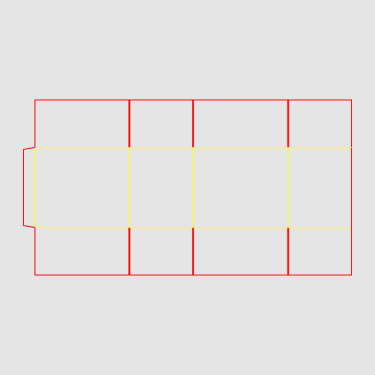
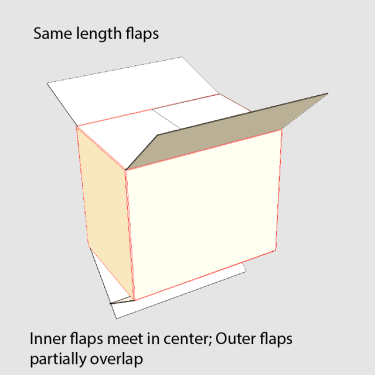
7. Center Special Full Overlap Slotted Carton(SFF, 0206)
This box style features flaps of different lengths. The inner flaps align at the center, and the outer flaps overlap, providing triple layers of corrugated cardboard at the top and bottom for extra protection.
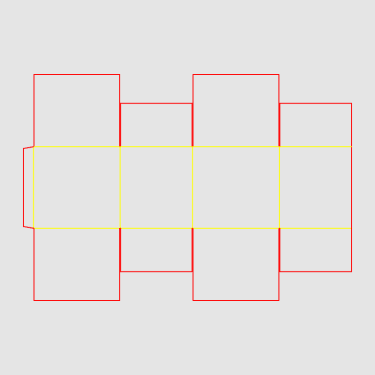

Benefits of Using a Custom Shipping Box Instead of a Standard One
Custom shipping boxes are a versatile and cost-effective way to ship products while ensuring that they arrive at their destination in perfect condition. Compared to standard packages, custom shipping boxes offer a range of benefits, making them an excellent choice for businesses looking to save money and improve their shipping operations.
1. Reduced Waste and Cost
The primary benefit of custom shipping boxes is that they can be designed to meet specific shipping needs. By creating a package that fits the product's dimensions, businesses can significantly reduce the amount of corrugated material used. This substantially reduces materials costs and dimensional weight (DIM) charges. In addition, removing the air from the container can reduce the size by up to 40% or more. This means you need up to 60% less void fill and a 26% reduction in corrugated material. These measures ensure the product is well-protected during transit and reduce the risk of damage or breakage.
2. Customizable Branding and Aesthetically Appealing
Custom shipping boxes can also be printed with branding, logos, or other design elements, increasing brand recognition and awareness. By featuring a business's logo or design on the box, companies can improve their brand visibility and create a more memorable customer experience.
3. High Quality and Durable Material
Custom shipping boxes are often made from high-quality materials, which improves their overall durability and longevity. This means the package can be reused multiple times, reducing waste and saving money in the long run. In addition, custom shipping boxes can be designed with specific features, such as reinforced corners or double-walled construction, to provide extra protection for fragile or valuable items.
4. Eco-Friendly
Custom shipping boxes are eco-friendly for businesses looking to reduce their environmental impact. They are often made from recycled materials and are almost 100% compostable, making them an excellent choice for companies looking to reduce their carbon footprint.
How to customize shipping boxes
Customizing a shipping box at CEF Box is a straightforward, four-step process.
Step 1: Dieline Drawing - First, create a precise dieline. Start by accurately measuring your products and recording their dimensions. Next, select the material you wish to use for your custom shipping box. Remember, the thickness can vary among materials, impacting your box's dimensions. Use our online dieline editor to enter these variables and produce an accurate dieline drawing. This process ensures your packaging fits your product perfectly, providing a polished, professional look.
Step 2: Graphic Design - Once you've finalized your dieline drawing, it's time to add some flair to graphic design. Our seasoned designers are ready and waiting to help create a unique, attention-grabbing design that embodies your brand.
Step 3: Configuring the Box - Get hands-on with our user-friendly online configurator. This tool lets you customize your box by selecting the size, material, coatings, finishes, and various printing options, making your snap-lock-bottom box unique.
Step 4: Place your Order - With the prior steps completed, it's time to place your order. Just sit back, relax, and let us do the rest. Our team will ensure your boxes are produced to the highest standards and arrive on time. With CEF Box, creating perfect, custom shipping boxes is a breeze.
